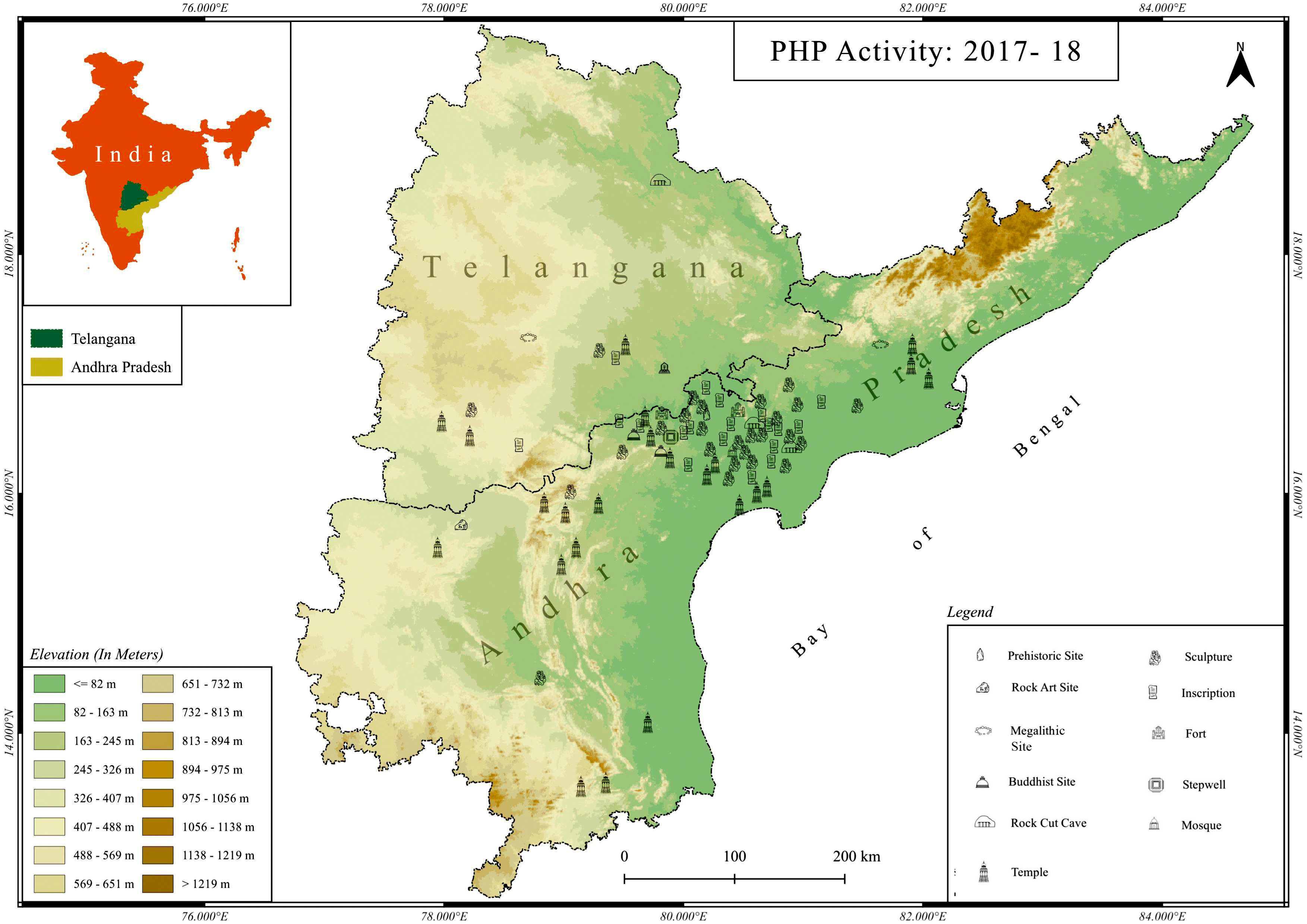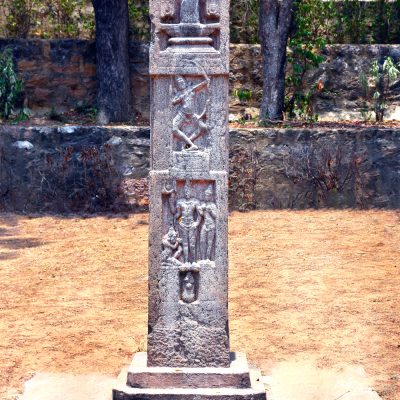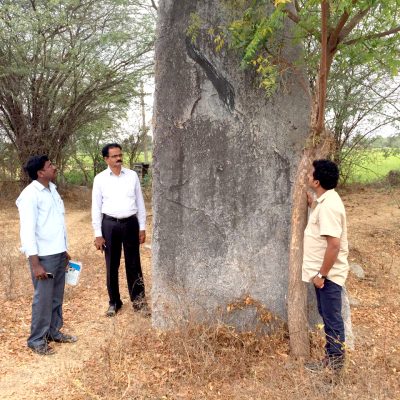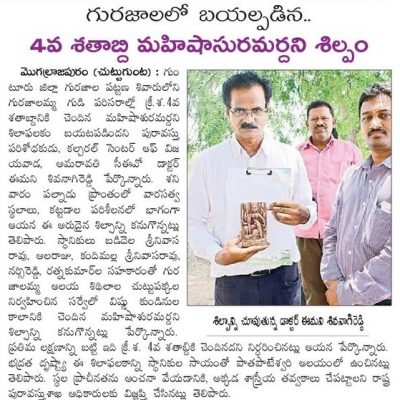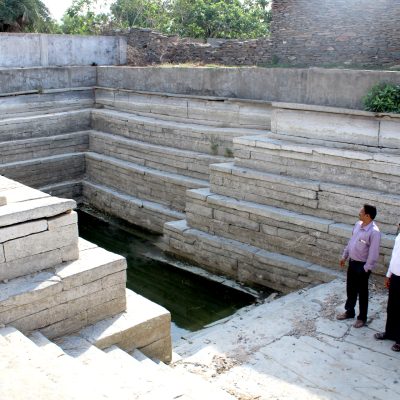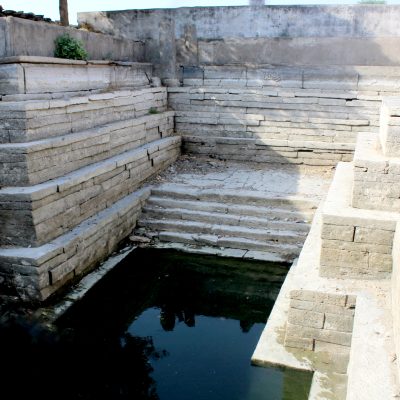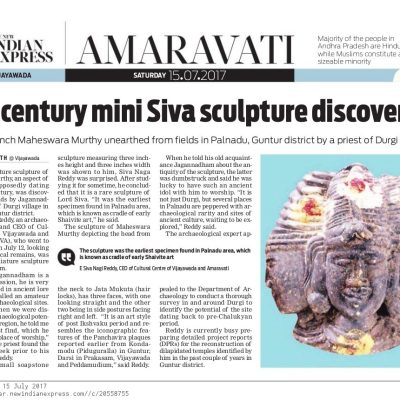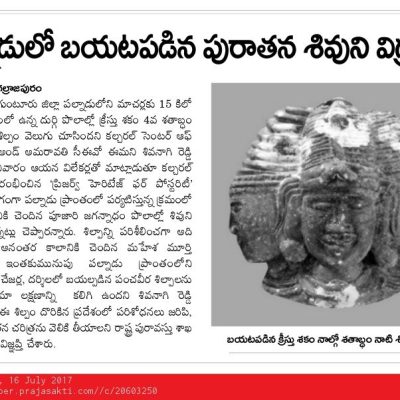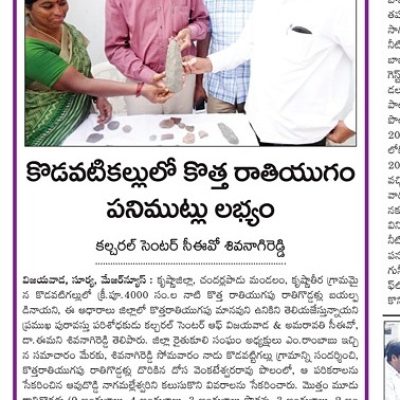Follow
Company
- Documentation
- Support
- Purchase
Site
03.01.2017
Pillars, 9th Cen. CE. Indrakeeladri Hill, Krishna, Andhra Pradesh
Findings
Partheswara Temple, perched atop the Indrakiladri hill, believed to have been constructed by Partha (Arjuna) in homage to Eswara.
a pillar, originally atop the hill, fell down in the courtyard of the Durga Malleswara temple in 1930.
This red sand stone pillar, with a 9th-century CE inscription, is now erected near Akkanna Madanna caves.
A mandapa nearby, originally part of the Mallesvarasvami temple compound, boasts of exquisitely carved pillars adorned with corbels and lintels, featuring Puranic narratives.
These four artistic pillars carry 43 inscriptions, of the 12th-13th centuries CE. One record even references a grant by a brother-in-law of the famous Kakatiya king Ganapathi Deva.
Call to Action
Emphasized the need to restore the pillar to its original location in front of the Partheswara temple atop the Indrakiladri hill. This move aims to create a stepped pathway from the Kanaka Durga Temple, facilitating devotees and research scholars with a more accessible approach, especially during the Krishna Pushkarams.Site
15.01.2017
Neglected Temple, 15th Cen. CE, Kothuru Tadepalli, Krishna, Andhra Pradesh
Findings
Identified a 600 years old Brick temple on the hillock at Kothur, a small village on Vijayawada- Velagaleru Road.
A Brick temple with an arthamandapa and Choultry built by Kumaragiri Reddy of the Kondavidu dynasty in 1397 CE who installed Vasantharaya Narasimha idol on the occasion of Makara Sankranti and also set up a huge inscription slab recording donation of lands at Kothur, Tadepalli, Koduru, Gollapudi, Velagaleru and Telaprolu the villages to the temple
The Temple is threatened by the growth of huge tree on the walls resulting in cracks and crevices threatening the very existence of the temple and other structures.
Call To Action
State Department of Archaeology and Museums have been urged to declare it as a protected Monument under the provisions of the act and take conservation and preservation measures for safeguarding the heritage structure.Site
23.01.2017
Temple in Neglect, 13th Cen. CE, Kolluru, Guntur Andhra Pradesh
Findings
Pathetic neglect of a 13th Cen. temple under the threat of submergence in the reservoir of Pulichintala Hydro project has been noticed at Kollurupet Village in Bellamkonda Mandal, Guntur Dt.
Explored a number of Medieval stone temples in the submerged villages of Pulichintala Project:
1) 17th Cen.Siva temple at Bodanam 2) 14th Cen. fort built by the Reddys of Kondavidu 3) Narasimha Swamy temple at Kethavaram 4) 12th century Inscription,13th century Siva temple at Kolluru and Anjaneya Temple at Kollurpet all along the river Krishna already submersed in the reservoir.
Call To Action
Appealed to the State Department of Archaeology and Museums to salvage the Kakatiya Temple and inscription for posterity by shifting to the rehabilitated village.Site
14.02.2017
Timmappa temple Gopura, 16th Cen. CE, Tondavada, Chandragiri Andhra Pradesh
Findings
Noted a 16th-century Gopura in the village of Tondavada, just 8 kilometers from Tirupati.
The structure, known locally as the 'Timmappa temple,' was constructed in the 16th century by Tallapala Chinnamma, the grandson of Tallapaka Annamacharya.
Unfortunately, the temple tower existing up to roof level suffered damage during an attack by enemy forces, causing the collapse of its superstructure.
Situated along the Tirupati-Chandragiri road at Tondavada, the Gopura is currently in a deteriorated state and in need of restoration.
Call To Action
Requested the TTD to take up this temple for proper Preservation. Further urged the Archaeology and Museums Dept. to declare it as a protected monument immediately for ensured safeguarding.Site
21.03.2017
Iron Age Menhir 1000 BCE, Padurivarigudem, Nalgonda, Andhra Pradesh
Findings
Found an Iron Age menhir in Padurivarigudem, Nalgonda district, dating back to 1000 BCE.
The 11 feet tall, 6 feet wide menhir, along with burial sites, faces threat from the on going agricultural activities in the area.
Call To Action
Appealed to the State Government to protect the unique menhir.Site
30.05.2017
Megalithic Monuments, 1000 BCE Rasakigullu, Hyderabad, Telangana
Findings
Identified Megalithic Monuments (Iron Age burials), dating back to 1000 BCE, situated on the Vijayawada-Hyderabad national highway are under threat due to road wideing.
Call To Action
Sensitized and raised awareness within the local grampanchayat to ensure the protection of the site.Site
02.06.2017
Mahishasuramardhini Sculpture 4th Cen CE. discovered, Gurajala, Andhra Pradesh
Findings
A rare Mahishasuramardhini sculpture (10x18x1cm) was found in Gurajala, Guntur district.
Based on iconographical style, the sculpture has been dated to post-Ikshvaku period (4th century CE).
The first of its kind sculpture is now safely kept in the local Patapateswari Temple.
Call To Action
Accompanied by Ratna Kumar - Director, Pilgrim Tourism, Endowments Department inspection of the dilapidated structure of the temple has been done. Explored the possibility of restoring it by retrieving the temple stones buried in the debris.Site
02.06.2017
Appeal for protection of 16th Cen. CE stepwell, Urabavi,
Guntur, Andhra Pradesh
Findings
Visited a step well of 16th Cen. located at Morjampadu village, Piduguralla mandal, Guntur district.
The L-shaped step well is constructed with proper steps and landings to facilitate villagers to fetch drinking water throughout the year.
Noteworthy features include two elephant sculptures serving as balustrades at the entrance, along with sculptures depicting snakes, fish, tortoises, Krishna's Kaliya Mardana, Gopika Vastrapaharama, rishis, and erotic motifs.
Call To Action
Accompanied by Ratna Kumar - Director, Pilgrim Tourism, Endowments Department inspection of the dilapidated structure of the temple has been done. Explored the possibility of restoring it by retrieving the temple stones buried in the debris.Site
15.07.2017
Mini Siva Sculpture 4th Cen. CE Discovered, Palnadu, Andhra Pradesh
Findings
A rare miniature sculpture of Maheshamurthy, an aspect of Lord Siva dating back to the 4th Cen. CE, was unearthed in the fields of Durgi village in Palnadu, Guntur district.
Call To Action
Appealed to the Department of Archaeology and Museums to conduct a thorough survey in and around Durgi to identify the potential of the site dating back to pre-chalukyan period.Site
16.08.2017
Historical Sculptures, 13th Cen CE. Gudimetla Fort, Krishna, Andhra Pradesh
Findings
Noticed 13th Cen. Kakatiya sculptures in a neglected state around Gudimetla Fort.
Call To Action
Urged the villagers and local authorities to take measures to safeguard and preserve these artifacts.Site
13.11.2017
Inscription found in a bush, 14th Cen CE. Mallavaram, Guntur, Andhra Pradesh
Findings
14th Cen. inscription of the time of Mallareddy the brother of Prolaya Vemareddy who had founded the Reddy Dynasty of Kondaveedu, was noticed in a thorny bush at Mallavaram.
Call To Action
Urged the villagers and local authorities to take measures to safeguard and preserve these artifacts.Site
25.11.2017
6000 years Old Neolithic Tools collected, Kondavati Kallu, Krishna, Andhra Pradesh
Findings
A Neolithic stone axe measuring approximately 9" in height, 3" in breadth, and 1.5" in width, of black granite stone was noticed.
Characterized by butt ends and a wide, finely polished cutting edge, these axes showcased the advanced stone tool-making technology employed by Neolithic people.
Call To Action
Appealed to the Department of Archaeology & Museums to take up a thorough probe in the area to know the archaeological potential of the village.Site
27.12.2017
Appeal to protect a Monument, 15th Cen. CE, Eguvareddyvaripalle, Chittoor, Andhra Pradesh
Findings
In an exploration in the fields of Eguvareddyvaripalle, located in the outskirts of Chandragiri Fort in Chittoor district, remains of a dilapidated mandapa, a temple structure enclosed by a massive compound wall, and scattered sculptures at Reddyvaripalle were noticed.
The 100-ft Gopura left uncared was constructed using granite stone up to the roof level and brick and lime mortar for the superstructure indicate. A vertical crack developed, causing damage to the structure.
The structures belonged to a sacrificial temple (Yagasala) of Siddhankkuttai Village in Vaikuntha Valanadu district, as per an inscription on the outer wall of the verandah of the record room in the first Prakara of Tirumala Temple. Dated to 1433 CE during the reign of Vijayanagara emperor Sri Veera Pratapa Devaraya II, the inscription recorded an agreement between the treasury of Sri Venkateswara Temple, the temple authorities, and the Mahajanas of the Village.
The Gopura, representing the typical Vijayanagara Style with its architectural elements and artistic finesse, once attracted royal and religious visitors for ritualistic purposes.
Call To Action
Sensitized the Villagers on the historical significance and heritage value of the structure and also appealed to the officials of Department of Archaeology and Museums and ASI to safeguard it.